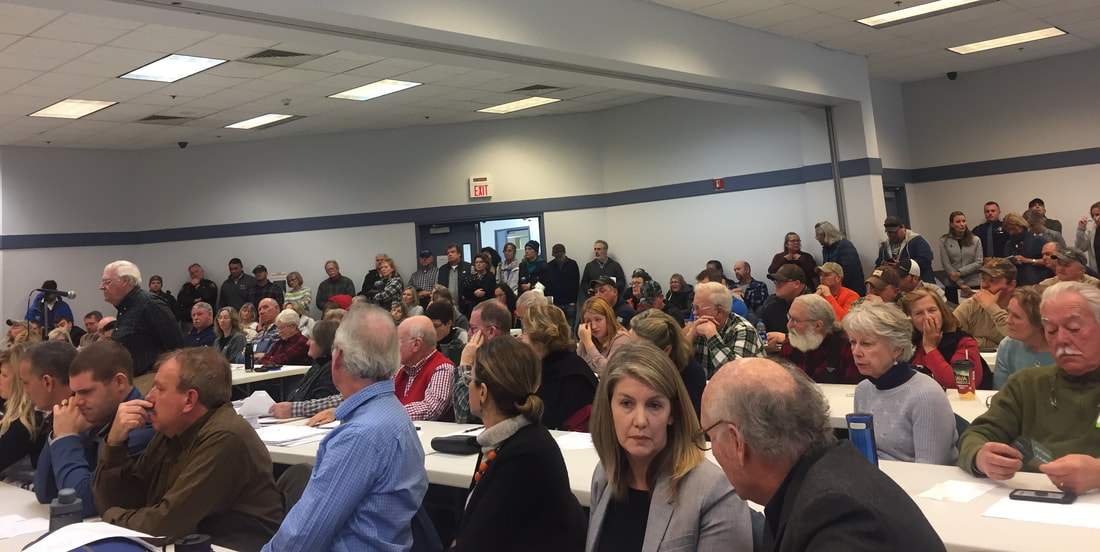Straits Tunnel Proposal
|
On October 3, 2018, the State of Michigan and Enbridge Energy announced a second Agreement between the State and Enbridge regarding Line 5 in Michigan. This Agreement calls for the State and Enbridge to initiate discussion on a multi-use utility tunnel beneath the Straits of Mackinac. The State is proposing that Enbridge would pay for all design, construction, operation, and maintenance of the tunnel for up to 99 years, subject to approvals by the Mackinac Bridge Authority. Tunnel construction is estimated to cost between $350 million to $500 million over a 7- to 10-year duration.
On November 8, 2018, the Mackinac Bridge Authority (MBA) heard from the State regarding a proposal for the Authority to oversee the construction, operation and maintenance of the utility tunnel. The presentations and a letter from Governor Snyder to the MBA can be accessed below. |
It was a packed house at the Mackinac Bridge Authority meeting in St. Ignace on November 8, 2018.
|
|
The MBA did not vote on the issue at the November 8th meeting. The next meeting of the MBA is scheduled for February 12 -13 in Lansing, the location TBD.
|
MDOT Live Video (recording) of the Mackinac Bridge Authority meeting held on November 8, 2018.
Please note that the audio is not very good, but the content is important. |
Senate Bill 1197 was introduced on November 8, 2018 by Senator Tom Casperson. The bill would allow the Mackinac Bridge Authority (MBA) to “acquire, construct, operate, maintain, improve, repair, and manage a utility tunnel.” The bill then allows for contracts or agreements to be made to perform these duties since the purpose is to have Enbridge construct and maintain a tunnel for private benefit. As part of the bill language, the MBA would be responsible for purchasing property or using easements in connection with the tunnel. In addition, the Authority is expected to secure or help secure all permits required for such a project. In summary, the MBA’s mission, which has historically been solely focused on the Mackinac Bridge, will be expanded to help Enbridge and other private utility companies make a profit. Adding insult to injury, the bill also includes a provision that exempts the utility tunnel from all taxes.
The Snyder-Enbridge agreement and Senate Bill 1197 threatens the long-term operation and maintenance of the Mighty Mac. It would have the Mackinac Bridge Authority (MBA) oversee the utility tunnel in the Straits, resulting in the following:
Click here to find your Senator. http://senate.michigan.gov/fysbyaddress.html
- It would change the focus and responsibility of the MBA, compromising the effectiveness of the MBA to manage the Mackinac Bridge.
- MBA would be required to defend Enbridge and the agreement in court, which could require a significant investment of money that could be otherwise used on Bridge operations.
- The Authority would subject to appropriations by the Legislature to fulfill its responsibilities related to the Tunnel. This would subject the MBA to political pressure and partisan politics, something it has always been immune to. It could also greatly impact the finances of the MBA.
- Bridge assets and revenues are dedicated to the Bridge operation and maintenance, but bonds are not. Bonds meant for the Mackinac Bridge could be diverted for the Tunnel.
Click here to find your Senator. http://senate.michigan.gov/fysbyaddress.html
The bill has been referred to the Senate Committee on Government Operations. Contact the Committee Members to voice your opposition to the MBA having an oversight role of a tunnel in the Straits.
Committee Members:
Committee Members:
- Arlan B Meekhof (R) Committee Chair, 30th District
- Goeff Hansen (R) Vice Chair, 34th District
- Mike Kowall (R) 15th District
- Jim Ananich D) Minority Vice Chair, 27th District
- Morris W Hood III (D) 3rd District
- Committee Clerk | 517-373-5307
|
Barbara J. Brown,
vice chairwoman of the Mackinac Bridge Authority |
Bridge Guest Commentary by Barbara J. Brown, vice chairwoman of the Mackinac Bridge Authority and granddaughter of Prentiss Brown, the first chairman of the bridge authority's board who served from 1950 to 1973.
Opinion: My family helped build the Mackinca Bridge. It shouldn't own Line 5 Tunnel.
https://www.bridgemi.com/guest-commentary/opinion-my-family-helped-build-mackinac-bridge-it-shouldnt-own-line-5-tunnel “Plans calling for the Mackinac Bridge Authority to own the proposed Enbridge Energy oil tunnel beneath the Straits of Mackinac are ill advised and not in the best interests of the Mackinac Bridge.” - Barbara J. Brown, vice chairwoman of the Mackinac Bridge Authority |
|
William H. Gnodtke
(1997-2018) |
“Since its creation in 1950, the Mackinac Bridge Authority (MBA) has had one focus – the Mackinac Bridge.” “Such a major expansion and altering of the authority’s responsibility to include a totally unrelated, highly complex project would mean a major dilution of the authority’s focus on the bridge. It has the potential to seriously compromise its effectiveness in managing Michigan’s single largest asset.”
- Excerpt from a statement by former Mackinac Bridge Authority Chairman, William Gnodtke. The statement is endorsed by 8 former members of the Mackinac Bridge Authority. |
OUR OPINION
In October, the State of Michigan and Enbridge Energy announced a second Agreement regarding Line 5 in Michigan. While the Agreement is being praised by the State as a solution that will protect the Great Lakes, in reality, the Agreement does not provide a final decision for the future of Line 5 and fails to protect the lifeblood of Michigan’s economy and way of life.
There are a number of concerns with the provisions included in the second Agreement, but of greatest concern is the State proposing that Enbridge negotiate a public-private partnership agreement with the Mackinac Bridge Authority for a utility tunnel in the Straits of Mackinac. The State is proposing that Enbridge would pay for all design, construction, operation and maintenance of the tunnel for up to 99 years, subject to approvals by the Mackinac Bridge Authority. Tunnel construction is estimated to cost between $350 million to $500 million over a 7- to 10-year duration.
First of all, it is important to recognize that the Agreement simply calls for initiation of discussions regarding a Straits tunnel. This does not mean the tunnel is agreed upon or even guaranteed to be constructed in the future. In fact, Enbridge’s official statement regarding the Agreement calls it merely “a commitment to explore the replacement of the Straits section of Line 5 with a tunnel under the lakebed that would contain a new pipeline.” (emphasis added) Should Enbridge and the State fail to reach a further agreement about a tunnel, Enbridge still has the ability to operate Line 5 in the Straits of Mackinac in its current form, under the 1953 Easement. This is far from a solution. Rather, the Agreement leaves Line 5 operational for an unknown amount of time into the future without requiring sufficient safeguards to prevent an oil spill.
Additionally, even if a tunnel was agreed to by Enbridge and the State of Michigan, a utility tunnel only addresses the risk posed by four miles of Line 5. Risk to Michigan’s waters, public health and safety, and our economy remain for the other 543 miles of Line 5 located within Michigan. The other 543 miles of Line 5 have nearly 400 sites where it crosses a waterbody. The inland portions can pose just as great, if not greater threat, due to the basic construction, operation, and maintenance of the line. The wall thickness of the inland pipeline is significantly less. It is 0.281 inches thick versus 0.813 inches at the Straits. Along with a thinner pipeline, it operates at a higher pressure. In addition, it has a side seam, which the Straits portion of pipe does not have. This seam can be subject to stress cracking and could cause the inland pipe to be more vulnerable. The inland portion is also not subject to the same inspection frequencies.
The Final Report Risk Analysis for the Straits Pipelines, prepared by Michigan Technological University, highlighted the risk associated with this inland portion of Line 5. The U.S. Coast Guard (USCG) personnel and emergency managers both pointed to the stretch of the pipeline along U.S. Highway 2 near Lake Michigan’s northern shore as their worst-case scenario. They cited the following concerns: less robust technology such as pipeline wall thickness and monitoring equipment; higher vulnerability to an errant strike and potential access problems for containment and cleanup equipment; and difficult terrain and environment for cleanup activities.
Lastly, comes the question of whether the Mackinac Bridge Authority has the expertise, duty, or even the willingness, to own and take responsibility for a tunnel filled with oil pipelines and electric transmission lines. The Bridge Authority, housed within the Department of Transportation, has a mission “to preserve and maintain the State of Michigan’s single largest asset and one of the world’s leading suspension bridges to provide safe, pleasurable and expedient passage over the Straits of Mackinac for economic benefit and improved quality of life.” A tunnel that serves private, shareholder owned energy companies does not fall under this mission. Not to mention the liability and potential economic complications that may come with ownership of a utility tunnel.
After a number of years of debate and studies, the State of Michigan had the opportunity to finally address the future of Line 5 and protect the waters and shoreline areas of Lakes Michigan and Huron, including those surrounding and adjacent to the Mackinac Straits. They failed to do so. A solution that would have actually protected Michigan’s waters and Great Lakes would have been for the Agreement to call for the decommissioning of Line 5 within a designated timeframe while discussions continue regarding alternatives.
Without a final solution, the conversations will continue on the future of Line 5. Enbridge will be presenting to the Mackinac Bridge Authority on November 8, 2018 from 9 am – noon at the Little Bear East Arena and Community Center in St. Ignace. The Mackinac Bridge Authority needs to hear from the public. They have done a fantastic job on operation and maintenance of the Mackinac Bridge and that is where their focus should remain. A tunnel is outside of their scope and will only distract from their mission.
In October, the State of Michigan and Enbridge Energy announced a second Agreement regarding Line 5 in Michigan. While the Agreement is being praised by the State as a solution that will protect the Great Lakes, in reality, the Agreement does not provide a final decision for the future of Line 5 and fails to protect the lifeblood of Michigan’s economy and way of life.
There are a number of concerns with the provisions included in the second Agreement, but of greatest concern is the State proposing that Enbridge negotiate a public-private partnership agreement with the Mackinac Bridge Authority for a utility tunnel in the Straits of Mackinac. The State is proposing that Enbridge would pay for all design, construction, operation and maintenance of the tunnel for up to 99 years, subject to approvals by the Mackinac Bridge Authority. Tunnel construction is estimated to cost between $350 million to $500 million over a 7- to 10-year duration.
First of all, it is important to recognize that the Agreement simply calls for initiation of discussions regarding a Straits tunnel. This does not mean the tunnel is agreed upon or even guaranteed to be constructed in the future. In fact, Enbridge’s official statement regarding the Agreement calls it merely “a commitment to explore the replacement of the Straits section of Line 5 with a tunnel under the lakebed that would contain a new pipeline.” (emphasis added) Should Enbridge and the State fail to reach a further agreement about a tunnel, Enbridge still has the ability to operate Line 5 in the Straits of Mackinac in its current form, under the 1953 Easement. This is far from a solution. Rather, the Agreement leaves Line 5 operational for an unknown amount of time into the future without requiring sufficient safeguards to prevent an oil spill.
Additionally, even if a tunnel was agreed to by Enbridge and the State of Michigan, a utility tunnel only addresses the risk posed by four miles of Line 5. Risk to Michigan’s waters, public health and safety, and our economy remain for the other 543 miles of Line 5 located within Michigan. The other 543 miles of Line 5 have nearly 400 sites where it crosses a waterbody. The inland portions can pose just as great, if not greater threat, due to the basic construction, operation, and maintenance of the line. The wall thickness of the inland pipeline is significantly less. It is 0.281 inches thick versus 0.813 inches at the Straits. Along with a thinner pipeline, it operates at a higher pressure. In addition, it has a side seam, which the Straits portion of pipe does not have. This seam can be subject to stress cracking and could cause the inland pipe to be more vulnerable. The inland portion is also not subject to the same inspection frequencies.
The Final Report Risk Analysis for the Straits Pipelines, prepared by Michigan Technological University, highlighted the risk associated with this inland portion of Line 5. The U.S. Coast Guard (USCG) personnel and emergency managers both pointed to the stretch of the pipeline along U.S. Highway 2 near Lake Michigan’s northern shore as their worst-case scenario. They cited the following concerns: less robust technology such as pipeline wall thickness and monitoring equipment; higher vulnerability to an errant strike and potential access problems for containment and cleanup equipment; and difficult terrain and environment for cleanup activities.
Lastly, comes the question of whether the Mackinac Bridge Authority has the expertise, duty, or even the willingness, to own and take responsibility for a tunnel filled with oil pipelines and electric transmission lines. The Bridge Authority, housed within the Department of Transportation, has a mission “to preserve and maintain the State of Michigan’s single largest asset and one of the world’s leading suspension bridges to provide safe, pleasurable and expedient passage over the Straits of Mackinac for economic benefit and improved quality of life.” A tunnel that serves private, shareholder owned energy companies does not fall under this mission. Not to mention the liability and potential economic complications that may come with ownership of a utility tunnel.
After a number of years of debate and studies, the State of Michigan had the opportunity to finally address the future of Line 5 and protect the waters and shoreline areas of Lakes Michigan and Huron, including those surrounding and adjacent to the Mackinac Straits. They failed to do so. A solution that would have actually protected Michigan’s waters and Great Lakes would have been for the Agreement to call for the decommissioning of Line 5 within a designated timeframe while discussions continue regarding alternatives.
Without a final solution, the conversations will continue on the future of Line 5. Enbridge will be presenting to the Mackinac Bridge Authority on November 8, 2018 from 9 am – noon at the Little Bear East Arena and Community Center in St. Ignace. The Mackinac Bridge Authority needs to hear from the public. They have done a fantastic job on operation and maintenance of the Mackinac Bridge and that is where their focus should remain. A tunnel is outside of their scope and will only distract from their mission.









